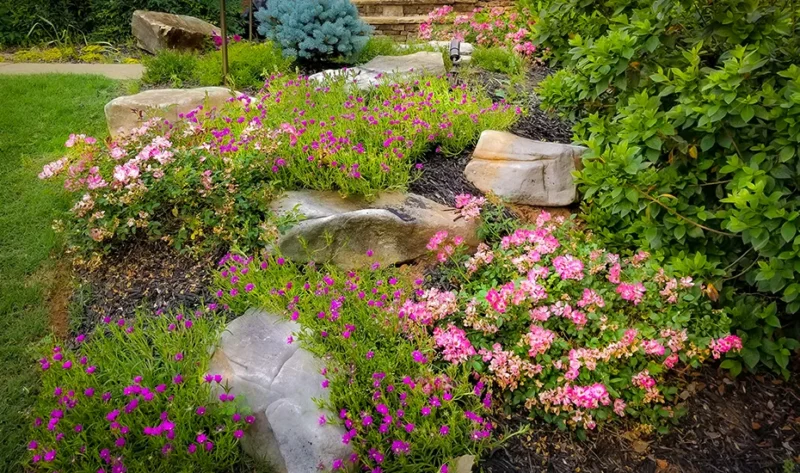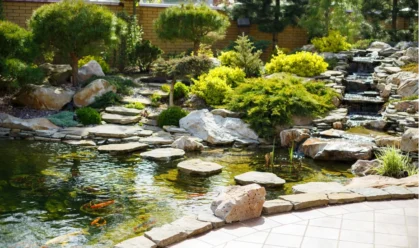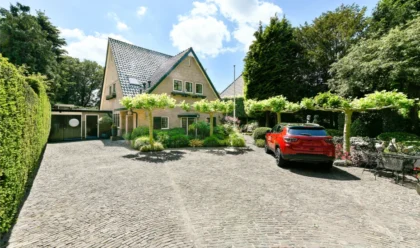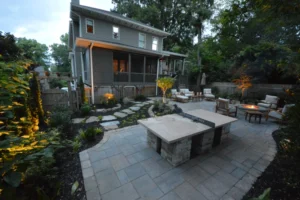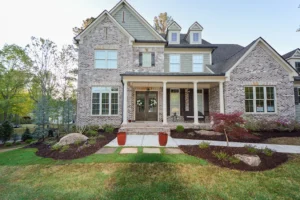When planning a hardscaping project, you may be more focused on the functionality and aesthetic appeal of your outdoor space. However, one essential aspect that you (like many homeowners) may overlook is proper drainage. Drainage is quintessential to your hardscaping features. Proper drainage can make a huge difference in your hardscape installation, from protecting your outdoor space from water damage and maintaining soil moisture levels to preventing erosion.

Unfortunately, if you don’t pay much attention to drainage, it can derail your hardscape installation’s beauty, longevity, and integrity. Let’s explore more reasons why proper drainage is so crucial to your hardscaping project:
The Benefits of Proper Drainage in Hardscape Projects
Atlanta’s unique climate, characterized by frequent rainfall and humid conditions, makes proper drainage an absolute necessity for successful hardscape installations. Here are some of the biggest benefits of proper drainage in your hardscaping projects:
1. Prevents Water Damage
In Atlanta, heavy rainstorms and seasonal thunderstorms can bring significant amounts of water in a short period. Without proper drainage, this excess water can pool around hardscape features like driveways and patios. This can lead to issues such as erosion of the base materials, which can cause the hardscape to shift or crack over time. By implementing effective drainage solutions, you can prevent these problems and protect your investment.
2. Extends Longevity
Atlanta experiences a mix of weather conditions, including humid summers and occasional winter freezes. These conditions can exacerbate issues like frost heave, where moisture trapped beneath hardscapes expands and causes damage when it freezes. Proper drainage helps to keep the sub-base dry and reduces the risk of such damage, thus extending the lifespan of your hardscape installations.

3. Reduces Maintenance Costs
Atlanta’s frequent rain can lead to quicker wear and tear on hardscapes if water isn’t properly managed. Standing water can lead to the growth of mold or algae on surfaces and can accelerate the deterioration of materials. Effective drainage minimizes these issues, reducing the need for frequent cleaning and repairs, and ultimately saving on maintenance costs.
4. Enhances Aesthetic Appeal
In Atlanta, hardscape features can be affected by water staining, algae growth, and erosion caused by poor drainage. These issues can detract from the beauty of your outdoor spaces. Proper drainage helps to maintain a clean and attractive appearance by preventing water-related damage and ensuring that your hardscape remains in top condition.
5. Improves Safety
Atlanta’s heavy rain and humid conditions can create slippery surfaces if water isn’t properly managed. This increases the risk of slips and falls, especially on hardscape features like walkways and stairs. Proper drainage helps to avoid standing water, making these surfaces safer for everyone using them.
6. Prevents Soil Erosion
The combination of heavy rainfall and the clayey soil common in Atlanta can lead to significant soil erosion. This erosion can undermine hardscape features and cause instability. Effective drainage systems help manage water flow, preventing soil from washing away and maintaining the integrity of both your hardscape and the surrounding landscape.
Potential Problems Caused By Poor Drainage
By addressing these potential problems through proper drainage solutions, you can protect your hardscape investments, maintain the safety and aesthetics of your outdoor spaces, and avoid costly repairs in the future:
Erosion and Undermining
Atlanta’s frequent and heavy rains can erode the soil around hardscape features if drainage is inadequate. This erosion can undermine the base materials supporting features like patios and retaining walls, leading to structural instability and uneven surfaces.

Cracking and Shifting
Water that pools around or beneath hardscape installations can cause shifting and cracking. In Atlanta, where temperatures can fluctuate, the combination of moisture and freezing conditions can exacerbate these issues, leading to costly repairs.
Pooled Water and Algae Growth
Poor drainage can result in standing water on hardscape surfaces, creating an environment where algae and mold can thrive. This not only detracts from the appearance of your hardscape but can also make surfaces slippery and hazardous.
Staining and Discoloration
Standing water and improper drainage can lead to staining and discoloration of hardscape materials. In Atlanta, where high humidity and rainfall are common, this can cause unsightly marks and degrade the visual appeal of your outdoor spaces.
Soil Erosion and Damage to Surrounding Landscape
Ineffective drainage can cause soil erosion around hardscape features, potentially damaging surrounding landscaping and plants. The erosion can wash away soil and undermine garden beds, leading to additional landscape maintenance challenges.
Increased Maintenance Costs
Addressing damage caused by poor drainage can lead to increased maintenance and repair costs. In Atlanta, where rain and humidity can accelerate wear and tear, keeping up with these repairs can become a significant financial burden.

Safety Hazards
Water accumulation due to poor drainage can create slippery surfaces, increasing the risk of slips and falls. In high-traffic areas like walkways and driveways, this can be a significant safety concern for residents and visitors.
Reduced Longevity of Materials
The combination of water damage and exposure to Atlanta’s climate can shorten the lifespan of hardscape materials. For instance, excessive moisture can cause stone and concrete to deteriorate more quickly, necessitating early replacement.
Best Drainage Solutions for Hardscape Features in Atlanta
French Drains
French drains are a popular choice for redirecting water away from hardscape areas. They consist of a trench filled with gravel and a perforated pipe that collects and channels water. This solution helps prevent water pooling around hardscapes and is effective for areas prone to heavy rainfall.
Channel Drains
Channel drains, or trench drains, are installed at the surface level to collect and direct surface water away from hardscapes. They are ideal for driveways, patios, and walkways, ensuring that water doesn’t pool and cause damage.
Gravel Beds
Gravel beds around hardscape features can help absorb and redirect water. They act as a buffer, allowing water to percolate into the ground rather than pooling or flowing towards the hardscape.
Proper Grading
Ensure that your hardscape areas are properly graded so that water flows away from the installation. This involves creating a slight slope away from hardscape features, which helps to naturally direct water to drainage systems or away from the property.
Permeable Pavers
Permeable pavers allow water to pass through the surface and be absorbed by the ground beneath. This reduces runoff and helps manage water flow around hardscape areas, preventing issues with standing water and erosion.
Gutters and Downspouts
Properly installed gutters and downspouts are crucial for managing roof runoff. Ensure that downspouts direct water away from hardscape areas and into appropriate drainage systems, such as French drains or dry wells.
Dry Wells
Dry wells are underground structures that collect and slowly release water into the surrounding soil. They are useful for managing excess runoff from hardscape areas and can be integrated into your drainage system to handle large volumes of water.

Swales
Swales are shallow, vegetated channels designed to direct and absorb water flow. They can be strategically placed around hardscape features to manage runoff and prevent erosion.
Catch Basins
Catch basins collect surface water and direct it into a drainage system. They can be installed around hardscape features to capture water before it causes pooling or damage.
Landscape Fabric and Mulch
Using landscape fabric and mulch can help manage water flow and reduce erosion around garden beds and hardscape features. Mulch can absorb water and prevent it from directly impacting hardscape surfaces.
Proper drainage is the cornerstone of any successful hardscaping project. Therefore, you should emphasize drainage solutions equally to maximize your hardscaping features and overall outdoor space. For the best drainage systems for your hardscape or landscape projects, it’s best to call outdoor construction and renovation professionals.













